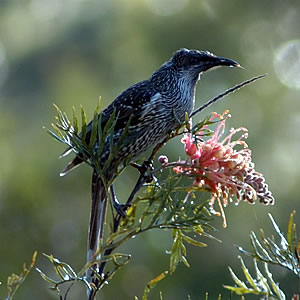|
| Query: bird | Result: 2199th of 32675 | |
Wattlebird (Meliphagidae) - Wiki
| Subject: | Wattlebird (Meliphagidae) - Wiki
| |

| Resolution: 300x300
File Size: 26186 Bytes
Upload Date: 2007:01:05 22:57:26
|
Wattlebird
From Wikipedia, the free encyclopedia
[Photo] Bird, Little Wattlebird, Anthochaera chrysoptera. Date Aug 2005. Author Brett Donald
Wattlebirds are members of the Honeyeater family, and native to Australia. Species of wattlebird include the Little Wattlebird, the Red Wattlebird, the Western Wattlebird, and the Yellow Wattlebird.
The entire Callaeidae family of New Zealand, comprised of the Tieke also known as the Saddleback, the Kokako, and the extinct Huia are wattlebirds.
Wattlebirds are characterized by their wattles. These are bare fleshy appendages, usually wrinkled and often brightly coloured, hanging from the cheeks, neck or throat, and presumably serving for display. The exception is the Little Wattlebird, which lacks wattles.
Some other birds also have wattles, although they are not known by the term "wattlebird". Examples include the Turkey; some vultures; and several species of lapwing.
http://en.wikipedia.org/wiki/Wattlebird
| The text in this page is based on the copyrighted Wikipedia article shown in above URL. It is used under the GNU Free Documentation License. You may redistribute it, verbatim or modified, providing that you comply with the terms of the GFDL. |
|
^o^
Animal Pictures Archive for smart phones
^o^
|
|